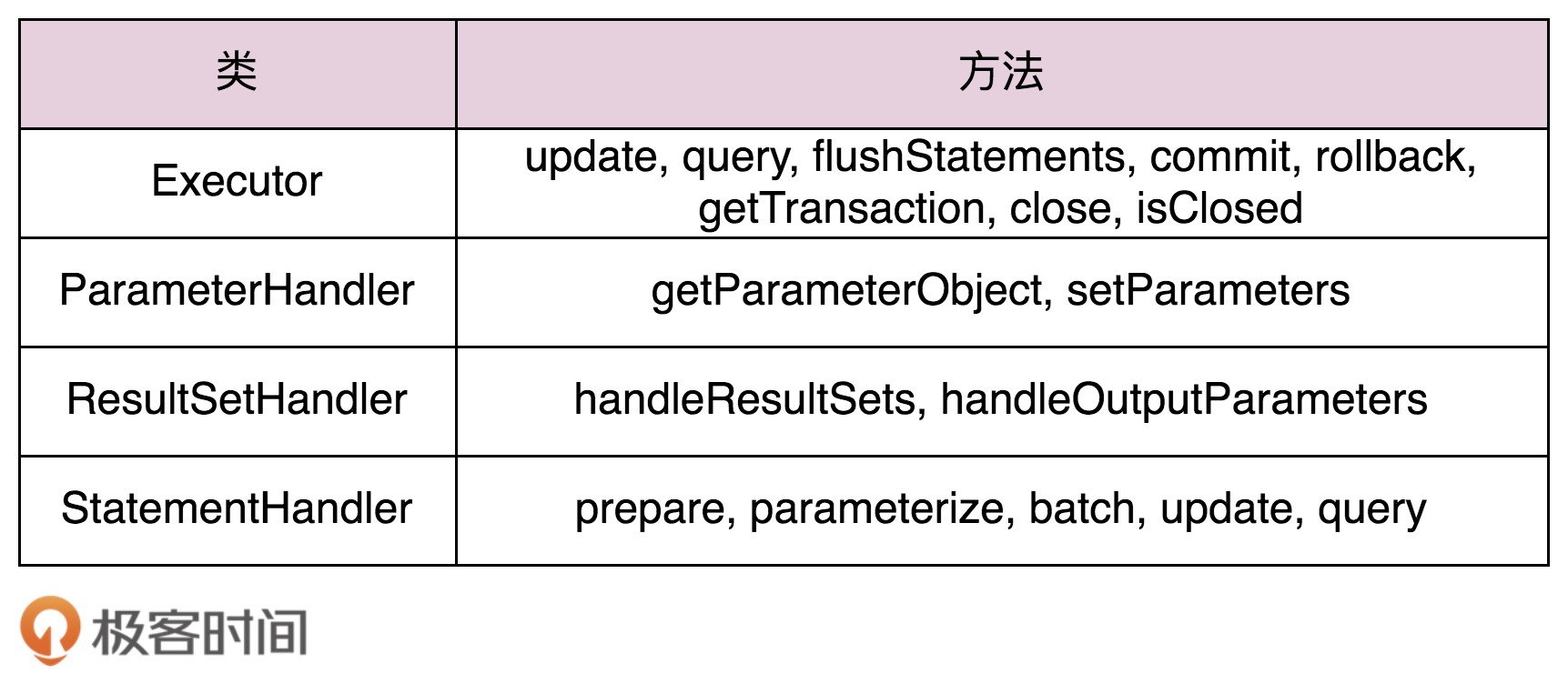19 KiB
上节课,我们对MyBatis框架做了简单的背景介绍,并且通过对比各种ORM框架,学习了代码的易用性、性能、灵活性之间的关系。一般来讲,框架提供的高级功能越多,那性能损耗就会越大;框架用起来越简单,提供越简化的使用方式,那灵活性也就越低。
接下来的两节课,我们再学习一下MyBatis用到一些经典设计模式。其中,今天,我们主要讲解MyBatis Plugin。尽管名字叫Plugin(插件),但它实际上跟之前讲到的Servlet Filter(过滤器)、Spring Interceptor(拦截器)类似,设计的初衷都是为了框架的扩展性,用到的主要设计模式都是职责链模式。
不过,相对于Servlet Filter和Spring Interceptor,MyBatis Plugin中职责链模式的代码实现稍微有点复杂。它是借助动态代理模式来实现的职责链。今天我就带你看下,如何利用这两个模式实现MyBatis Plugin。
话不多说,让我们正式开始今天的学习吧!
MyBatis Plugin功能介绍
实际上,MyBatis Plugin跟Servlet Filter、Spring Interceptor的功能是类似的,都是在不需要修改原有流程代码的情况下,拦截某些方法调用,在拦截的方法调用的前后,执行一些额外的代码逻辑。它们的唯一区别在于拦截的位置是不同的。Servlet Filter主要拦截Servlet请求,Spring Interceptor主要拦截Spring管理的Bean方法(比如Controller类的方法等),而MyBatis Plugin主要拦截的是MyBatis在执行SQL的过程中涉及的一些方法。
MyBatis Plugin使用起来比较简单,我们通过一个例子来快速看下。
假设我们需要统计应用中每个SQL的执行耗时,如果使用MyBatis Plugin来实现的话,我们只需要定义一个SqlCostTimeInterceptor类,让它实现MyBatis的Interceptor接口,并且,在MyBatis的全局配置文件中,简单声明一下这个插件就可以了。具体的代码和配置如下所示:
@Intercepts({
@Signature(type = StatementHandler.class, method = "query", args = {Statement.class, ResultHandler.class}),
@Signature(type = StatementHandler.class, method = "update", args = {Statement.class}),
@Signature(type = StatementHandler.class, method = "batch", args = {Statement.class})})
public class SqlCostTimeInterceptor implements Interceptor {
private static Logger logger = LoggerFactory.getLogger(SqlCostTimeInterceptor.class);
@Override
public Object intercept(Invocation invocation) throws Throwable {
Object target = invocation.getTarget();
long startTime = System.currentTimeMillis();
StatementHandler statementHandler = (StatementHandler) target;
try {
return invocation.proceed();
} finally {
long costTime = System.currentTimeMillis() - startTime;
BoundSql boundSql = statementHandler.getBoundSql();
String sql = boundSql.getSql();
logger.info("执行 SQL:[ {} ]执行耗时[ {} ms]", sql, costTime);
}
}
@Override
public Object plugin(Object target) {
return Plugin.wrap(target, this);
}
@Override
public void setProperties(Properties properties) {
System.out.println("插件配置的信息:"+properties);
}
}
<!-- MyBatis全局配置文件:mybatis-config.xml -->
<plugins>
<plugin interceptor="com.xzg.cd.a88.SqlCostTimeInterceptor">
<property name="someProperty" value="100"/>
</plugin>
</plugins>
因为待会我会详细地介绍MyBatis Plugin的底层实现原理,所以,这里暂时不对上面的代码做详细地解释。现在,我们只重点看下@Intercepts注解这一部分。
我们知道,不管是拦截器、过滤器还是插件,都需要明确地标明拦截的目标方法。@Intercepts注解实际上就是起了这个作用。其中,@Intercepts注解又可以嵌套@Signature注解。一个@Signature注解标明一个要拦截的目标方法。如果要拦截多个方法,我们可以像例子中那样,编写多条@Signature注解。
@Signature注解包含三个元素:type、method、args。其中,type指明要拦截的类、method指明方法名、args指明方法的参数列表。通过指定这三个元素,我们就能完全确定一个要拦截的方法。
默认情况下,MyBatis Plugin允许拦截的方法有下面这样几个:

为什么默认允许拦截的是这样几个类的方法呢?
MyBatis底层是通过Executor类来执行SQL的。Executor类会创建StatementHandler、ParameterHandler、ResultSetHandler三个对象,并且,首先使用ParameterHandler设置SQL中的占位符参数,然后使用StatementHandler执行SQL语句,最后使用ResultSetHandler封装执行结果。所以,我们只需要拦截Executor、ParameterHandler、ResultSetHandler、StatementHandler这几个类的方法,基本上就能满足我们对整个SQL执行流程的拦截了。
实际上,除了统计SQL的执行耗时,利用MyBatis Plugin,我们还可以做很多事情,比如分库分表、自动分页、数据脱敏、加密解密等等。如果感兴趣的话,你可以自己实现一下。
MyBatis Plugin的设计与实现
刚刚我们简单介绍了MyBatis Plugin是如何使用的。现在,我们再剖析一下源码,看看如此简洁的使用方式,底层是如何实现的,隐藏了哪些复杂的设计。
相对于Servlet Filter、Spring Interceptor中职责链模式的代码实现,MyBatis Plugin的代码实现还是蛮有技巧的,因为它是借助动态代理来实现职责链的。
在第62节和第63节中,我们讲到,职责链模式的实现一般包含处理器(Handler)和处理器链(HandlerChain)两部分。这两个部分对应到Servlet Filter的源码就是Filter和FilterChain,对应到Spring Interceptor的源码就是HandlerInterceptor和HandlerExecutionChain,对应到MyBatis Plugin的源码就是Interceptor和InterceptorChain。除此之外,MyBatis Plugin还包含另外一个非常重要的类:Plugin。它用来生成被拦截对象的动态代理。
集成了MyBatis的应用在启动的时候,MyBatis框架会读取全局配置文件(前面例子中的mybatis-config.xml文件),解析出Interceptor(也就是例子中的SqlCostTimeInterceptor),并且将它注入到Configuration类的InterceptorChain对象中。这部分逻辑对应到源码如下所示:
public class XMLConfigBuilder extends BaseBuilder {
//解析配置
private void parseConfiguration(XNode root) {
try {
//省略部分代码...
pluginElement(root.evalNode("plugins")); //解析插件
} catch (Exception e) {
throw new BuilderException("Error parsing SQL Mapper Configuration. Cause: " + e, e);
}
}
//解析插件
private void pluginElement(XNode parent) throws Exception {
if (parent != null) {
for (XNode child : parent.getChildren()) {
String interceptor = child.getStringAttribute("interceptor");
Properties properties = child.getChildrenAsProperties();
//创建Interceptor类对象
Interceptor interceptorInstance = (Interceptor) resolveClass(interceptor).newInstance();
//调用Interceptor上的setProperties()方法设置properties
interceptorInstance.setProperties(properties);
//下面这行代码会调用InterceptorChain.addInterceptor()方法
configuration.addInterceptor(interceptorInstance);
}
}
}
}
// Configuration类的addInterceptor()方法的代码如下所示
public void addInterceptor(Interceptor interceptor) {
interceptorChain.addInterceptor(interceptor);
}
我们再来看Interceptor和InterceptorChain这两个类的代码,如下所示。Interceptor的setProperties()方法就是一个单纯的setter方法,主要是为了方便通过配置文件配置Interceptor的一些属性值,没有其他作用。Interceptor类中intecept()和plugin()函数,以及InterceptorChain类中的pluginAll()函数,是最核心的三个函数,我们待会再详细解释。
public class Invocation {
private final Object target;
private final Method method;
private final Object[] args;
// 省略构造函数和getter方法...
public Object proceed() throws InvocationTargetException, IllegalAccessException {
return method.invoke(target, args);
}
}
public interface Interceptor {
Object intercept(Invocation invocation) throws Throwable;
Object plugin(Object target);
void setProperties(Properties properties);
}
public class InterceptorChain {
private final List<Interceptor> interceptors = new ArrayList<Interceptor>();
public Object pluginAll(Object target) {
for (Interceptor interceptor : interceptors) {
target = interceptor.plugin(target);
}
return target;
}
public void addInterceptor(Interceptor interceptor) {
interceptors.add(interceptor);
}
public List<Interceptor> getInterceptors() {
return Collections.unmodifiableList(interceptors);
}
}
解析完配置文件之后,所有的Interceptor都加载到了InterceptorChain中。接下来,我们再来看下,这些拦截器是在什么时候被触发执行的?又是如何被触发执行的呢?
前面我们提到,在执行SQL的过程中,MyBatis会创建Executor、StatementHandler、ParameterHandler、ResultSetHandler这几个类的对象,对应的创建代码在Configuration类中,如下所示:
public Executor newExecutor(Transaction transaction, ExecutorType executorType) {
executorType = executorType == null ? defaultExecutorType : executorType;
executorType = executorType == null ? ExecutorType.SIMPLE : executorType;
Executor executor;
if (ExecutorType.BATCH == executorType) {
executor = new BatchExecutor(this, transaction);
} else if (ExecutorType.REUSE == executorType) {
executor = new ReuseExecutor(this, transaction);
} else {
executor = new SimpleExecutor(this, transaction);
}
if (cacheEnabled) {
executor = new CachingExecutor(executor);
}
executor = (Executor) interceptorChain.pluginAll(executor);
return executor;
}
public ParameterHandler newParameterHandler(MappedStatement mappedStatement, Object parameterObject, BoundSql boundSql) {
ParameterHandler parameterHandler = mappedStatement.getLang().createParameterHandler(mappedStatement, parameterObject, boundSql);
parameterHandler = (ParameterHandler) interceptorChain.pluginAll(parameterHandler);
return parameterHandler;
}
public ResultSetHandler newResultSetHandler(Executor executor, MappedStatement mappedStatement, RowBounds rowBounds, ParameterHandler parameterHandler,
ResultHandler resultHandler, BoundSql boundSql) {
ResultSetHandler resultSetHandler = new DefaultResultSetHandler(executor, mappedStatement, parameterHandler, resultHandler, boundSql, rowBounds);
resultSetHandler = (ResultSetHandler) interceptorChain.pluginAll(resultSetHandler);
return resultSetHandler;
}
public StatementHandler newStatementHandler(Executor executor, MappedStatement mappedStatement, Object parameterObject, RowBounds rowBounds, ResultHandler resultHandler, BoundSql boundSql) {
StatementHandler statementHandler = new RoutingStatementHandler(executor, mappedStatement, parameterObject, rowBounds, resultHandler, boundSql);
statementHandler = (StatementHandler) interceptorChain.pluginAll(statementHandler);
return statementHandler;
}
从上面的代码中,我们可以发现,这几个类对象的创建过程都调用了InteceptorChain的pluginAll()方法。这个方法的代码前面已经给出了。你可以回过头去再看一眼。它的代码实现很简单,嵌套调用InterceptorChain上每个Interceptor的plugin()方法。plugin()是一个接口方法(不包含实现代码),需要由用户给出具体的实现代码。在之前的例子中,SQLTimeCostInterceptor的plugin()方法通过直接调用Plugin的wrap()方法来实现。wrap()方法的代码实现如下所示:
// 借助Java InvocationHandler实现的动态代理模式
public class Plugin implements InvocationHandler {
private final Object target;
private final Interceptor interceptor;
private final Map<Class<?>, Set<Method>> signatureMap;
private Plugin(Object target, Interceptor interceptor, Map<Class<?>, Set<Method>> signatureMap) {
this.target = target;
this.interceptor = interceptor;
this.signatureMap = signatureMap;
}
// wrap()静态方法,用来生成target的动态代理,
// 动态代理对象=target对象+interceptor对象。
public static Object wrap(Object target, Interceptor interceptor) {
Map<Class<?>, Set<Method>> signatureMap = getSignatureMap(interceptor);
Class<?> type = target.getClass();
Class<?>[] interfaces = getAllInterfaces(type, signatureMap);
if (interfaces.length > 0) {
return Proxy.newProxyInstance(
type.getClassLoader(),
interfaces,
new Plugin(target, interceptor, signatureMap));
}
return target;
}
// 调用target上的f()方法,会触发执行下面这个方法。
// 这个方法包含:执行interceptor的intecept()方法 + 执行target上f()方法。
@Override
public Object invoke(Object proxy, Method method, Object[] args) throws Throwable {
try {
Set<Method> methods = signatureMap.get(method.getDeclaringClass());
if (methods != null && methods.contains(method)) {
return interceptor.intercept(new Invocation(target, method, args));
}
return method.invoke(target, args);
} catch (Exception e) {
throw ExceptionUtil.unwrapThrowable(e);
}
}
private static Map<Class<?>, Set<Method>> getSignatureMap(Interceptor interceptor) {
Intercepts interceptsAnnotation = interceptor.getClass().getAnnotation(Intercepts.class);
// issue #251
if (interceptsAnnotation == null) {
throw new PluginException("No @Intercepts annotation was found in interceptor " + interceptor.getClass().getName());
}
Signature[] sigs = interceptsAnnotation.value();
Map<Class<?>, Set<Method>> signatureMap = new HashMap<Class<?>, Set<Method>>();
for (Signature sig : sigs) {
Set<Method> methods = signatureMap.get(sig.type());
if (methods == null) {
methods = new HashSet<Method>();
signatureMap.put(sig.type(), methods);
}
try {
Method method = sig.type().getMethod(sig.method(), sig.args());
methods.add(method);
} catch (NoSuchMethodException e) {
throw new PluginException("Could not find method on " + sig.type() + " named " + sig.method() + ". Cause: " + e, e);
}
}
return signatureMap;
}
private static Class<?>[] getAllInterfaces(Class<?> type, Map<Class<?>, Set<Method>> signatureMap) {
Set<Class<?>> interfaces = new HashSet<Class<?>>();
while (type != null) {
for (Class<?> c : type.getInterfaces()) {
if (signatureMap.containsKey(c)) {
interfaces.add(c);
}
}
type = type.getSuperclass();
}
return interfaces.toArray(new Class<?>[interfaces.size()]);
}
}
实际上,Plugin是借助Java InvocationHandler实现的动态代理类。用来代理给target对象添加Interceptor功能。其中,要代理的target对象就是Executor、StatementHandler、ParameterHandler、ResultSetHandler这四个类的对象。wrap()静态方法是一个工具函数,用来生成target对象的动态代理对象。
当然,只有interceptor与target互相匹配的时候,wrap()方法才会返回代理对象,否则就返回target对象本身。怎么才算是匹配呢?那就是interceptor通过@Signature注解要拦截的类包含target对象,具体可以参看wrap()函数的代码实现(上面一段代码中的第16~19行)。
MyBatis中的职责链模式的实现方式比较特殊。它对同一个目标对象嵌套多次代理(也就是InteceptorChain中的pluginAll()函数要执行的任务)。每个代理对象(Plugin对象)代理一个拦截器(Interceptor对象)功能。为了方便你查看,我将pluginAll()函数的代码又拷贝到了下面。
public Object pluginAll(Object target) {
// 嵌套代理
for (Interceptor interceptor : interceptors) {
target = interceptor.plugin(target);
// 上面这行代码等于下面这行代码,target(代理对象)=target(目标对象)+interceptor(拦截器功能)
// target = Plugin.wrap(target, interceptor);
}
return target;
}
// MyBatis像下面这样创建target(Executor、StatementHandler、ParameterHandler、ResultSetHandler),相当于多次嵌套代理
Object target = interceptorChain.pluginAll(target);
当执行Executor、StatementHandler、ParameterHandler、ResultSetHandler这四个类上的某个方法的时候,MyBatis会嵌套执行每层代理对象(Plugin对象)上的invoke()方法。而invoke()方法会先执行代理对象中的interceptor的intecept()函数,然后再执行被代理对象上的方法。就这样,一层一层地把代理对象上的intercept()函数执行完之后,MyBatis才最终执行那4个原始类对象上的方法。
重点回顾
好了,今天内容到此就讲完了。我们来一块总结回顾一下,你需要重点掌握的内容。
今天,我们带你剖析了如何利用职责链模式和动态代理模式来实现MyBatis Plugin。至此,我们就已经学习了三种职责链常用的应用场景:过滤器(Servlet Filter)、拦截器(Spring Interceptor)、插件(MyBatis Plugin)。
职责链模式的实现一般包含处理器和处理器链两部分。这两个部分对应到Servlet Filter的源码就是Filter和FilterChain,对应到Spring Interceptor的源码就是HandlerInterceptor和HandlerExecutionChain,对应到MyBatis Plugin的源码就是Interceptor和InterceptorChain。除此之外,MyBatis Plugin还包含另外一个非常重要的类:Plugin类。它用来生成被拦截对象的动态代理。
在这三种应用场景中,职责链模式的实现思路都不大一样。其中,Servlet Filter采用递归来实现拦截方法前后添加逻辑。Spring Interceptor的实现比较简单,把拦截方法前后要添加的逻辑放到两个方法中实现。MyBatis Plugin采用嵌套动态代理的方法来实现,实现思路很有技巧。
课堂讨论
Servlet Filter、Spring Interceptor可以用来拦截用户自己定义的类的方法,而MyBatis Plugin默认可以拦截的只有Executor、StatementHandler、ParameterHandler、ResultSetHandler这四个类的方法,而且这四个类是MyBatis实现的类,并非用户自己定义的类。那MyBatis Plugin为什么不像Servlet Filter、Spring Interceptor那样,提供拦截用户自定义类的方法的功能呢?
欢迎留言和我分享你的想法。如果有收获,也欢迎你把这篇文章分享给你的朋友。